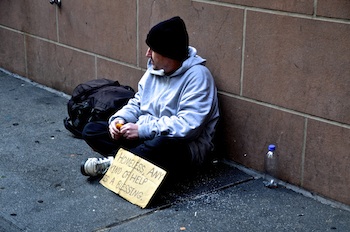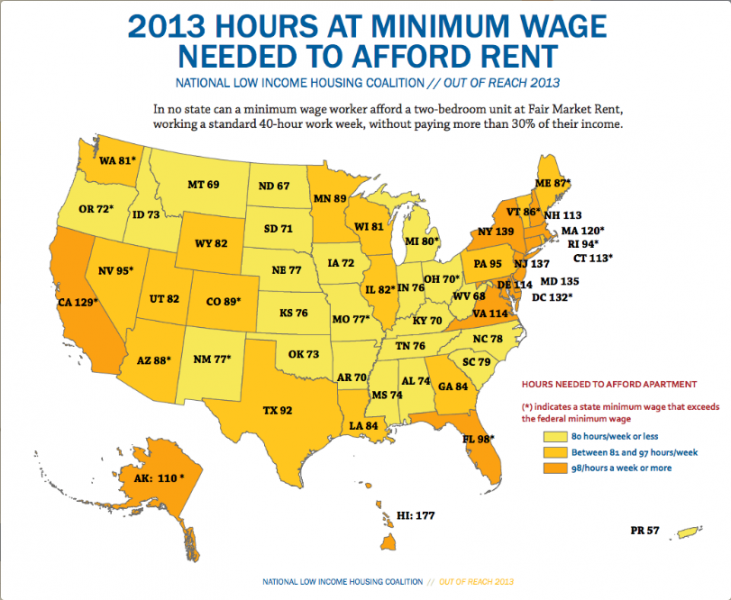Minimum Wage And Homelessness In America
The Fair

Since the current minimum wage can no longer adequately serve as the primary income for most American families, analysts believe that the fluctuating minimum wage may be responsible for an increase in the number of people living without homes or any sense of income security.
The following video shows just how complex the history of minimum wage has been in the United States.
READ MORE: L.A. County's Homeless Youth Numbers Continue To Rise
The need to determine how people become homeless was uncovered in a study done by the U.S. Conference of Mayors in 2008. The study showed that lack of affordable housing, poverty and unemployment are the three main causes of homelessness in families.
Currently, there are a total of 1.75 million homeless people in the United States, with an average monthly income of $348. The majority of these homeless individuals are either single men or families with children. Minority groups also make up a significant proportion of the homeless population. 44 percent of these homeless people did paid work in the past month in a low-income job, and only 25 percent of homeless people are currently employed—the vast majority of them making minimum wage.

In 1967, a person working at minimum wage could raise a family of three just above the poverty line. Now, a family of four will remain almost $6000 below the poverty line if the sole breadwinner works a minimum wage job.
In 2011, there were 10.1 million individuals wanted to rent a house, despite being classified as "extremely low income"—households earning no more than 30 percent of the annual medium income. For those 10.1 million, there were only 4.6 million affordable rental units. Conversely, people who earn an average median income are faced with a surplus of housing options.
READ MORE: Homeowners Facing Foreclosure Appeal To Lenders For Relief
The issue in this housing crisis is that lower income families who spend a majority of their income on rent and utilities are at greater risk for homelessness. There seem to be two options available in order to alleviate this homelessness disparity: either raise the minimum wage so that homeless individuals can afford housing or provide more available housing options for people with low income
The first option may seem preferable in the short term; people getting paid more means more money to buy a house or rent an apartment.
“The short answer is that you’d have to raise minimum wage a LOT for people to be able to afford housing in California,” according to Chris Maxwell, grants and communication manager of the California Housing Partnership Corporation. The raise may, however, actually have long-term negative effects that would throw more people under the poverty line and potentially into homelessness.
Raising the minimum wage can have a negative impact on companies by rendering them unable to afford paying all the workers at a higher price. As a result, many jobs may be forced to fire workers because they cannot afford to pay them at a higher rate. This could lead to stagnation in many companies because there are not enough workers to do the job.
READ MORE: California's Minimum Wage Hike Boosts Workers' Morale
Many believe that providing more available housing options for low-income individuals is the more manageable option with fewer risks attached. Companies like the National Low Income Housing Coalition have been working tirelessly to come up with solutions to provide homeless individuals with affordable housing options.
Their three goals are to preserve existing federally assisted homes, expand the supply of low-income housing and establish housing stability. NLIHC also funds the National Housing Trust Fund, which was established as a provision to the Housing and Economic Recovery act of 2008. This fund will help build, preserve and rehabilitate rental homes for low-income families around the United States.
The California Housing Partnership Corporation “provides technical assistance and financial consulting to nonprofit and government housing agencies who directly own and operate affordable housing” says Maxwell. The company makes use of NLIHC’s data resources to help determine what the next steps are in terms of finances.
Companies like the NLIHC and the CHPC work together in order to create more affordable housing for those in need. The issue at hand goes far beyond the numbers and speculations about the future of minimum wage and whether or not it will positively or negatively impact homelessness; there is a substantial economic disparity in the United States and it is affecting children and families.
The capitalist system in the United States is an ideal breeding ground for individuals who want to earn big bucks; yet the true nature of the issue is that the rich continue to get richer while the poor get even poorer.
Yes, the minimum wage is an issue that continues to be debated hotly on both sides of the congressional isle and yes, there are companies out there that work tirelessly to create affordable housing for low-income individuals, but the issue at hand comes from deeper roots. It comes from the structure of our society and how we perceive the wealth distribution is in the United States versus how the wealth distribution actually is.
Reach Staff Reporter Niki Hashemi here and follow her on Twitter.



